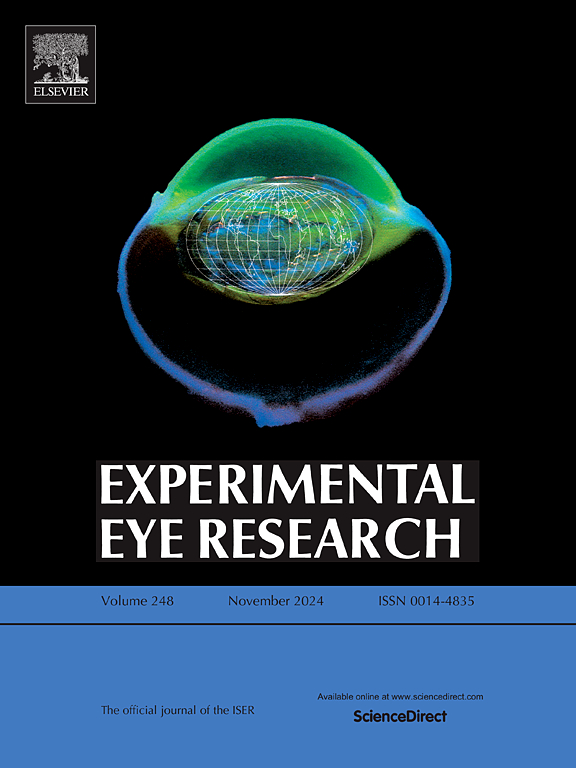AAV2.7m8 transduction of stage 2 human retinal organoids induces highly variable responses in innate and inflammatory gene expression and cytokine secretion
IF 2.7
2区 医学
Q1 OPHTHALMOLOGY
引用次数: 0
Abstract
The preclinical evaluation of recombinant AAV (rAAV) gene therapy vectors should consider host innate and inflammatory immune responses which can cause harmful ocular inflammation and decrease the efficiency of transgene delivery. In this study we determined which cell types expressed the transgene following transduction of 75-day-old human pluripotent stem cell (hPSC)-derived retinal organoids (RO) with the gene delivery vector AAV2.7m8-CAG-EGFP (AAVGFP). We then examined the changes in RO inflammatory gene expression and cytokine secretion following AAVGFP transduction. Our results indicated that RO cell types including photoreceptors (PR), retinal progenitor cells (RPCs), retinal ganglion cells (RGC), horizontal cells, and amacrine cells were transduced by AAVGFP. PCR array analysis following AAVGFP RO transduction detected up regulation of innate and adaptive immune response genes including chemokine (CC) genes, cluster of differentiation (CD) genes, interleukin (IL) genes, and transcription factors. The changes in gene expression following RO transduction varied drastically depending on the manufacturer and the production lot of AAVGFP, and were also not consistent between RO batches transduced with the same lot of AAVGFP. Analysis of RO supernatants indicated that several pro- and anti-inflammatory cytokines including sCD40L, IL-4, IL-6, IL-10, IL-13, IL-17A and MCP-1 were secreted following AAVGFP transduction, but the secretion pattern of these cytokines varied between transductions. These data indicate that intermediate-stage differentiating human ROs derived from the same hPSC line have highly variable responses to rAAV gene delivery vectors.
2期人视网膜类器官的AAV2.7m8转导在先天和炎症基因表达和细胞因子分泌方面诱导高度可变的反应。
重组AAV (rAAV)基因治疗载体的临床前评估应考虑宿主的先天免疫和炎症免疫反应,这些免疫反应可引起有害的眼部炎症,降低转基因传递的效率。在这项研究中,我们用基因传递载体AAV2.7m8-CAG-EGFP (AAVGFP)转导75日龄的人多能干细胞(hPSC)衍生的视网膜类器官(RO),确定了哪些细胞类型表达了转基因。然后,我们检测了AAVGFP转导后RO炎症基因表达和细胞因子分泌的变化。研究结果表明,AAVGFP可介导光感受器(PR)、视网膜祖细胞(rpc)、视网膜神经节细胞(RGC)、水平细胞和无突细胞等RO细胞类型。AAVGFP RO转导后的PCR阵列分析检测到先天和适应性免疫反应基因上调,包括趋化因子(CC)基因、分化簇(CD)基因、白细胞介素(IL)基因和转录因子。RO转导后基因表达的变化随着AAVGFP的生产厂家和生产批次的不同而有很大的差异,并且在用相同批次AAVGFP转导的RO批次之间也不一致。RO上清分析表明,AAVGFP转导后可分泌sCD40L、IL-4、IL-6、IL-10、IL-13、IL-17A和MCP-1等促炎和抗炎细胞因子,但这些细胞因子的分泌模式因转导而异。这些数据表明,来自同一hPSC系的中期分化人ROs对rAAV基因传递载体的反应高度可变。
本文章由计算机程序翻译,如有差异,请以英文原文为准。
求助全文
约1分钟内获得全文
求助全文
来源期刊

Experimental eye research
医学-眼科学
CiteScore
6.80
自引率
5.90%
发文量
323
审稿时长
66 days
期刊介绍:
The primary goal of Experimental Eye Research is to publish original research papers on all aspects of experimental biology of the eye and ocular tissues that seek to define the mechanisms of normal function and/or disease. Studies of ocular tissues that encompass the disciplines of cell biology, developmental biology, genetics, molecular biology, physiology, biochemistry, biophysics, immunology or microbiology are most welcomed. Manuscripts that are purely clinical or in a surgical area of ophthalmology are not appropriate for submission to Experimental Eye Research and if received will be returned without review.
 求助内容:
求助内容: 应助结果提醒方式:
应助结果提醒方式:


